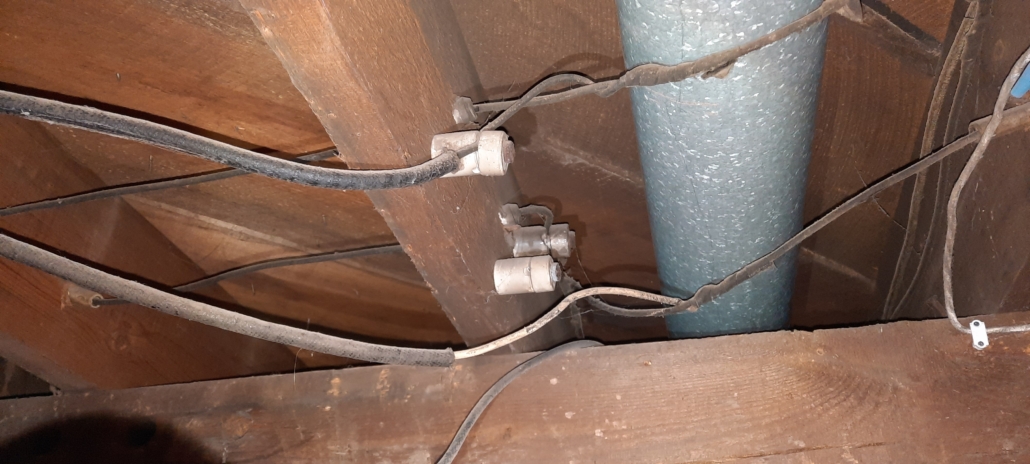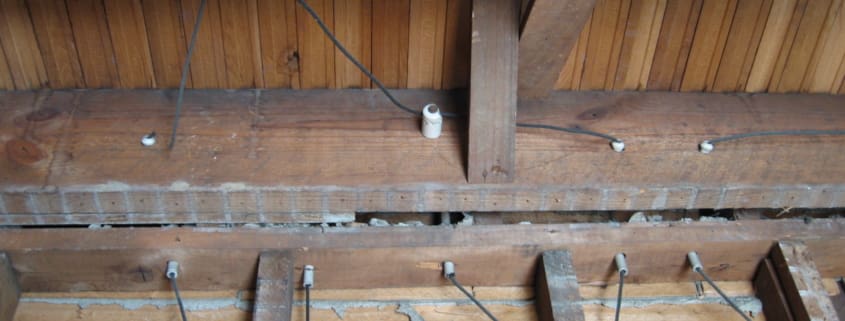Knob & Tube Wiring: What Homeowners Need to Know
Knob and tube wiring, once the standard for electrical systems in homes, is now a relic of the past. If you own or are considering purchasing an older home in Minnesota, understanding knob and tube wiring is crucial for ensuring the safety and functionality of your property. This comprehensive guide will delve into the history, identification, risks, and options for upgrading knob and tube wiring, providing Minnesota homeowners with the knowledge needed to make informed decisions.
What is Knob & Tube Wiring?
Knob and tube wiring, also known as K&T, was the first standardized method of electrical wiring in homes. Used predominantly from the 1880s to the 1940s, it features single-insulated copper wires run through porcelain tubes and supported by porcelain knobs. While it was state-of-the-art at the time, K&T wiring lacks many of the safety features found in modern electrical systems.
Components and Functionality
K&T wiring consists of two primary components: ceramic knobs and tubes. The ceramic knobs secure the wires to the wooden frame of the house, while the tubes protect the wires as they pass through the wooden structure. The wires themselves are usually covered in a cloth-based insulation, which, over time, becomes brittle and deteriorates.
Knob and tube wiring differs from modern wiring in that it lacks a ground wire. Modern wiring includes three wires: hot, neutral, and ground, which enhance safety by providing a direct path for electricity to the earth in case of a fault. K&T wiring only includes hot and neutral wires, which makes it less safe, especially with today’s electrical demands.
Advantages and Disadvantages of Knob & Tube Wiring
Advantages:
- Cost-Effective: When it was first installed, K&T wiring was cost-effective due to its simple design and ease of installation.
- Flexibility: The separation of wires allowed for more flexibility in running electrical circuits throughout the house.
- Air Cooling: The open-air installation allowed the wires to cool naturally, reducing the risk of overheating.
Disadvantages:
- No Grounding: The absence of a ground wire increases the risk of electrical shock and fire hazards, especially with modern appliances.
- Aging Insulation: Over time, the cloth insulation becomes brittle and can deteriorate, leading to exposed wires and increased fire risk.
- Limited Capacity: K&T wiring was not designed to handle the high electrical loads common in modern homes, making it prone to overheating.
Identification of Knob & Tube Wiring
Identifying knob and tube wiring is essential for homeowners, especially those in older Minnesota homes. Recognizing this outdated system can help you address potential safety concerns before they become serious issues.
Visual Inspection
The most straightforward way to identify knob and tube wiring is through a visual inspection. Look in your attic, basement, or crawl spaces for black or white cloth-covered wires supported by ceramic knobs. These wires may also pass through ceramic tubes where they run through walls or joists. If you see these distinctive components, your home likely has K&T wiring.
Consult Historical Records
For older homes, consulting historical records, blueprints, or previous home inspection reports can provide insights into the electrical system’s age and type. These documents may indicate whether the home was originally wired with knob and tube or if it has been updated.
Hire a Professional Electrician
Given the potential dangers associated with K&T wiring, hiring a professional electrician for a thorough assessment is advisable. An electrician can confirm the presence of knob and tube wiring, evaluate its condition, and recommend any necessary upgrades or replacements.

Potential Risks and Issues with Knob & Tube Wiring
While K&T wiring was effective in its time, it poses several risks for today’s homeowners. Understanding these risks can help you make informed decisions about whether to upgrade or replace your home’s electrical system.
Fire Hazards
One of the most significant risks associated with knob and tube wiring is the potential for fire. The cloth insulation used in K&T systems degrades over time, leading to exposed wires that can spark or overheat. In addition, the lack of a ground wire means that faults or surges can result in electrical fires, especially if the system is overloaded.
Deterioration Over Time
As knob and tube wiring ages, the materials used can deteriorate. The cloth insulation becomes brittle and may fall away from the wires, exposing them to air and moisture. This exposure increases the likelihood of arcing and electrical faults, which can cause power outages, shocks, or fires. Regular inspections are necessary to catch these issues before they become serious hazards.
Incompatibility with Modern Appliances
Knob and tube wiring was designed for the electrical demands of the early 20th century, which were significantly lower than today’s requirements. Modern appliances, such as refrigerators, air conditioners, and microwaves, draw much more power, which can overload K&T wiring. This overloading can lead to overheating, blown fuses, or even fires.
Upgrading or Replacing Knob & Tube Wiring
Given the risks associated with knob and tube wiring, many homeowners choose to upgrade to modern electrical systems. Here’s what you need to know about upgrading or replacing K&T wiring in your home.
When to Upgrade
An upgrade is necessary if your home’s knob and tube wiring shows signs of wear, if you plan to install new appliances that require grounding, or if you’re undertaking major renovations. Additionally, if your insurance company requires it or refuses coverage due to the presence of knob and tube wiring, an upgrade becomes essential.
Options for Replacement
Replacing knob and tube wiring involves installing modern wiring systems that meet current safety standards. This typically means rewiring the entire home with modern insulated wiring, which includes a ground wire. This process can be costly but is necessary for ensuring the safety and functionality of your home’s electrical system.
In some cases, partial upgrades may be possible. For example, you may choose to replace the wiring in areas where it is most likely to be overloaded, such as the kitchen and bathroom, while leaving the K&T wiring in less critical areas like attics or basements. However, full replacement is the safest and most effective solution.
Benefits of Upgrading
Upgrading to modern wiring systems offers several benefits:
- Enhanced Safety: Modern wiring includes grounding and better insulation, reducing the risk of shocks and fires.
- Increased Home Value: Homes with modern electrical systems are more attractive to buyers and can command higher prices on the market.
- Lower Insurance Premiums: Many insurance companies charge higher premiums for homes with K&T wiring or may refuse coverage altogether. Upgrading can reduce your premiums and ensure coverage.
Insurance Implications of Knob & Tube Wiring
Knob and tube wiring can significantly impact your homeowner’s insurance coverage. Many insurance companies view K&T wiring as a higher risk due to its age and lack of safety features.
Impact on Insurance Coverage
Some insurance companies may refuse to insure homes with knob and tube wiring, while others may offer coverage at a higher premium. It’s essential to disclose the presence of K&T wiring to your insurer to avoid complications in the event of a claim.
Steps to Take
If your home has knob and tube wiring, consider obtaining a thorough inspection and report from a licensed electrician. Present this report to your insurance company, along with any upgrades or safety measures you’ve implemented. This proactive approach can help you secure coverage or reduce your premiums.
Considerations for Insurance Companies
Insurance companies consider several factors when determining coverage, including the age and condition of the wiring, the presence of safety upgrades, and whether the system complies with current codes. Upgrading to modern wiring can significantly reduce your premiums and increase your coverage options.
The Importance of Addressing Knob & Tube Wiring
Understanding knob and tube wiring is crucial for homeowners, especially those in older homes. While K&T wiring served its purpose well in the past, it presents significant risks today. Proactive management, regular inspections, and professional advice are essential for maintaining a safe and functional home. If you suspect your home has knob and tube wiring, consult with a licensed electrician and consider upgrading to a modern system to protect your property and your peace of mind.
For expert advice and thorough home inspections in Minnesota, contact MCR Home Inspections today. Our experienced team will help you identify potential risks and provide recommendations tailored to your home’s needs. Schedule your inspection today or call 715-919-8054.





Leave a Reply
Want to join the discussion?Feel free to contribute!